MGT 501 Presentation: Social Sustainability & Child Labor Analysis
VerifiedAdded on 2023/06/15
|9
|860
|226
Presentation
AI Summary
This business presentation delves into the complex issue of child labor in third-world countries, examining its legality, ethical implications, and the prevalence of physical abuse. It highlights how child labor, despite sometimes providing income for impoverished families, is largely viewed as immoral and illegal, especially considering the hazardous conditions and potential for exploitation. The presentation references laws prohibiting child labor in countries like Pakistan and India and explores the negative impacts on the labor market, including suppressed wage growth and reduced human capital accumulation. The resources used are peer-reviewed journal articles from 2012-2018, ensuring current and reliable data on the challenges and health hazards faced by child laborers, aiming to raise awareness and promote ethical business practices.

Business
presentation on
social sustainability
Name- Mayankkumar Modi
Id no. 11642313
subject name- MGT 501
presentation on
social sustainability
Name- Mayankkumar Modi
Id no. 11642313
subject name- MGT 501
Paraphrase This Document
Need a fresh take? Get an instant paraphrase of this document with our AI Paraphraser

introduction
This presentation analyses the legality, ethics,
evidences of physical abuse from the aspect of
Child labour in various companies branched in the
third world countries. It also include the effect of
child labour in the labour market of that region. The
presentation concludes with discussing the
resources as evidences of the argument.
This presentation analyses the legality, ethics,
evidences of physical abuse from the aspect of
Child labour in various companies branched in the
third world countries. It also include the effect of
child labour in the labour market of that region. The
presentation concludes with discussing the
resources as evidences of the argument.
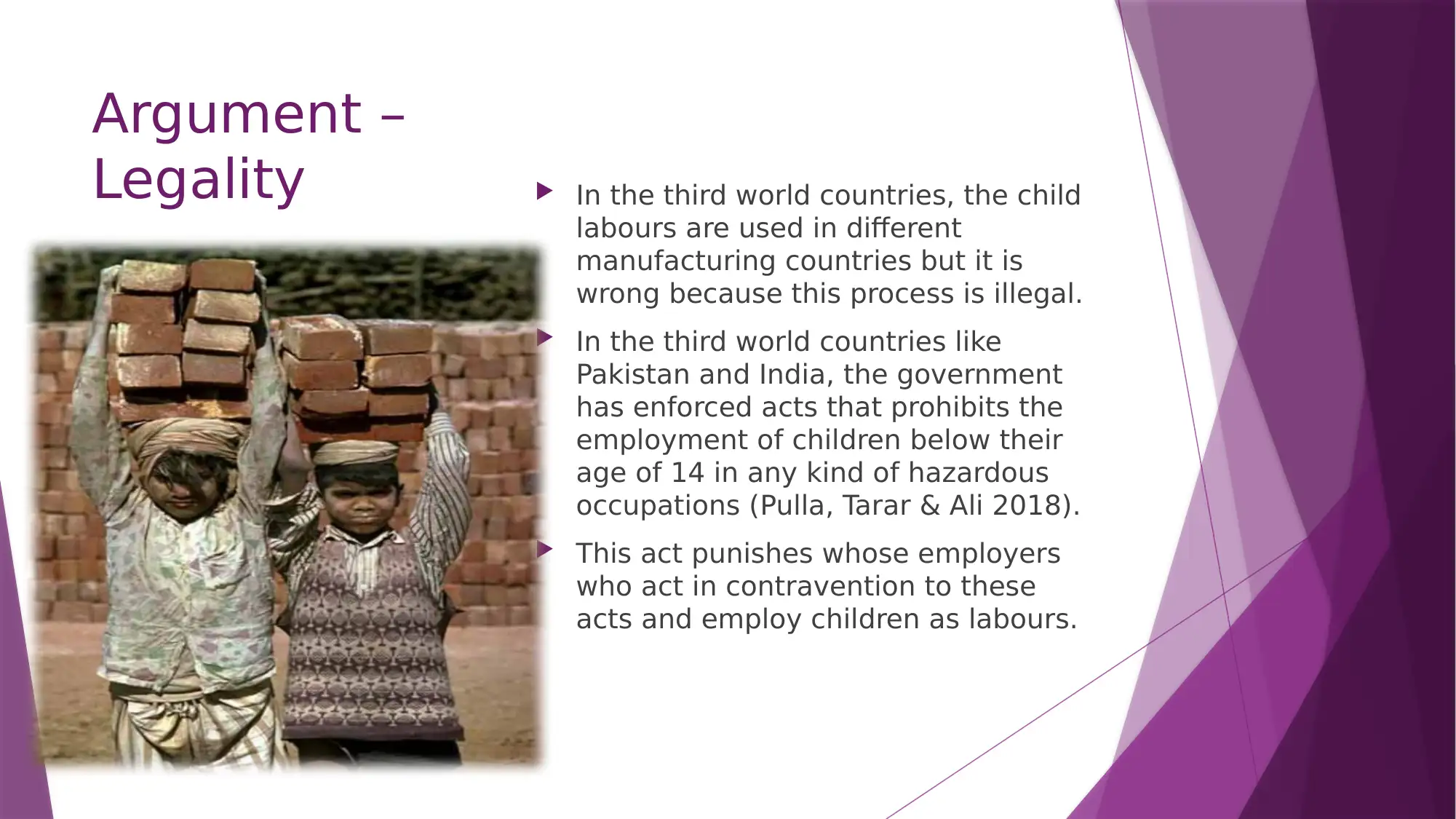
Argument –
Legality In the third world countries, the child
labours are used in different
manufacturing countries but it is
wrong because this process is illegal.
In the third world countries like
Pakistan and India, the government
has enforced acts that prohibits the
employment of children below their
age of 14 in any kind of hazardous
occupations (Pulla, Tarar & Ali 2018).
This act punishes whose employers
who act in contravention to these
acts and employ children as labours.
Legality In the third world countries, the child
labours are used in different
manufacturing countries but it is
wrong because this process is illegal.
In the third world countries like
Pakistan and India, the government
has enforced acts that prohibits the
employment of children below their
age of 14 in any kind of hazardous
occupations (Pulla, Tarar & Ali 2018).
This act punishes whose employers
who act in contravention to these
acts and employ children as labours.
⊘ This is a preview!⊘
Do you want full access?
Subscribe today to unlock all pages.

Trusted by 1+ million students worldwide
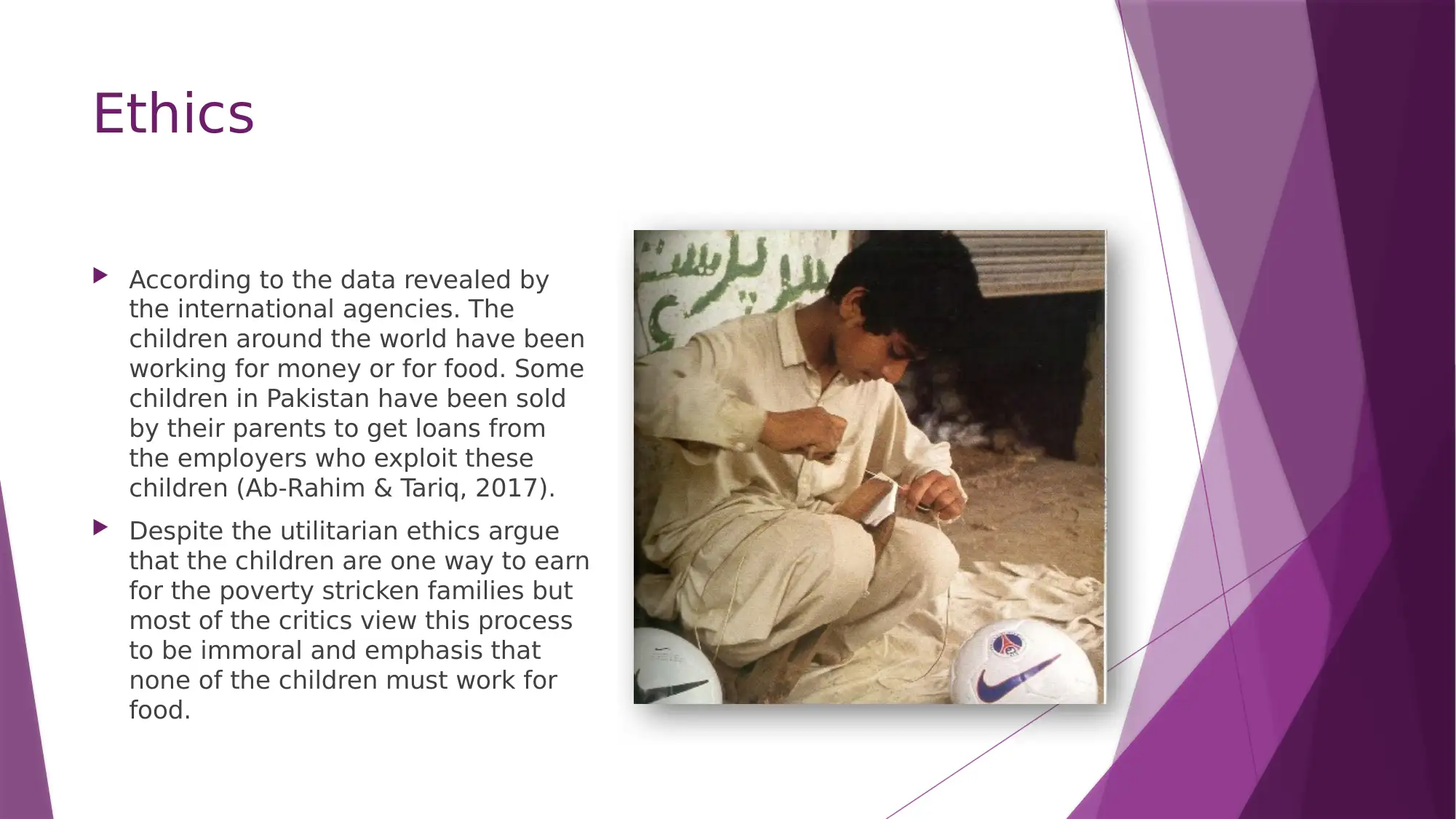
Ethics
According to the data revealed by
the international agencies. The
children around the world have been
working for money or for food. Some
children in Pakistan have been sold
by their parents to get loans from
the employers who exploit these
children (Ab-Rahim & Tariq, 2017).
Despite the utilitarian ethics argue
that the children are one way to earn
for the poverty stricken families but
most of the critics view this process
to be immoral and emphasis that
none of the children must work for
food.
According to the data revealed by
the international agencies. The
children around the world have been
working for money or for food. Some
children in Pakistan have been sold
by their parents to get loans from
the employers who exploit these
children (Ab-Rahim & Tariq, 2017).
Despite the utilitarian ethics argue
that the children are one way to earn
for the poverty stricken families but
most of the critics view this process
to be immoral and emphasis that
none of the children must work for
food.
Paraphrase This Document
Need a fresh take? Get an instant paraphrase of this document with our AI Paraphraser

Evidence of physical abuse
Physical abuse is not very rare
issue in the process of child labour.
The children working for hours
after hours become slow or make
mistakes and whines then they are
brutally beaten and physically
tortured.
Small children are forced to climb
under some dangerous cloth
manufacturing machines as well as
handle hazardous objects with their
bare hands.
In some cases, the girl child
labours are victims of sexual abuse
(Zakar et al., 2015). The corrupt
employees pursue the children as
their sexual pray.
Physical abuse is not very rare
issue in the process of child labour.
The children working for hours
after hours become slow or make
mistakes and whines then they are
brutally beaten and physically
tortured.
Small children are forced to climb
under some dangerous cloth
manufacturing machines as well as
handle hazardous objects with their
bare hands.
In some cases, the girl child
labours are victims of sexual abuse
(Zakar et al., 2015). The corrupt
employees pursue the children as
their sexual pray.
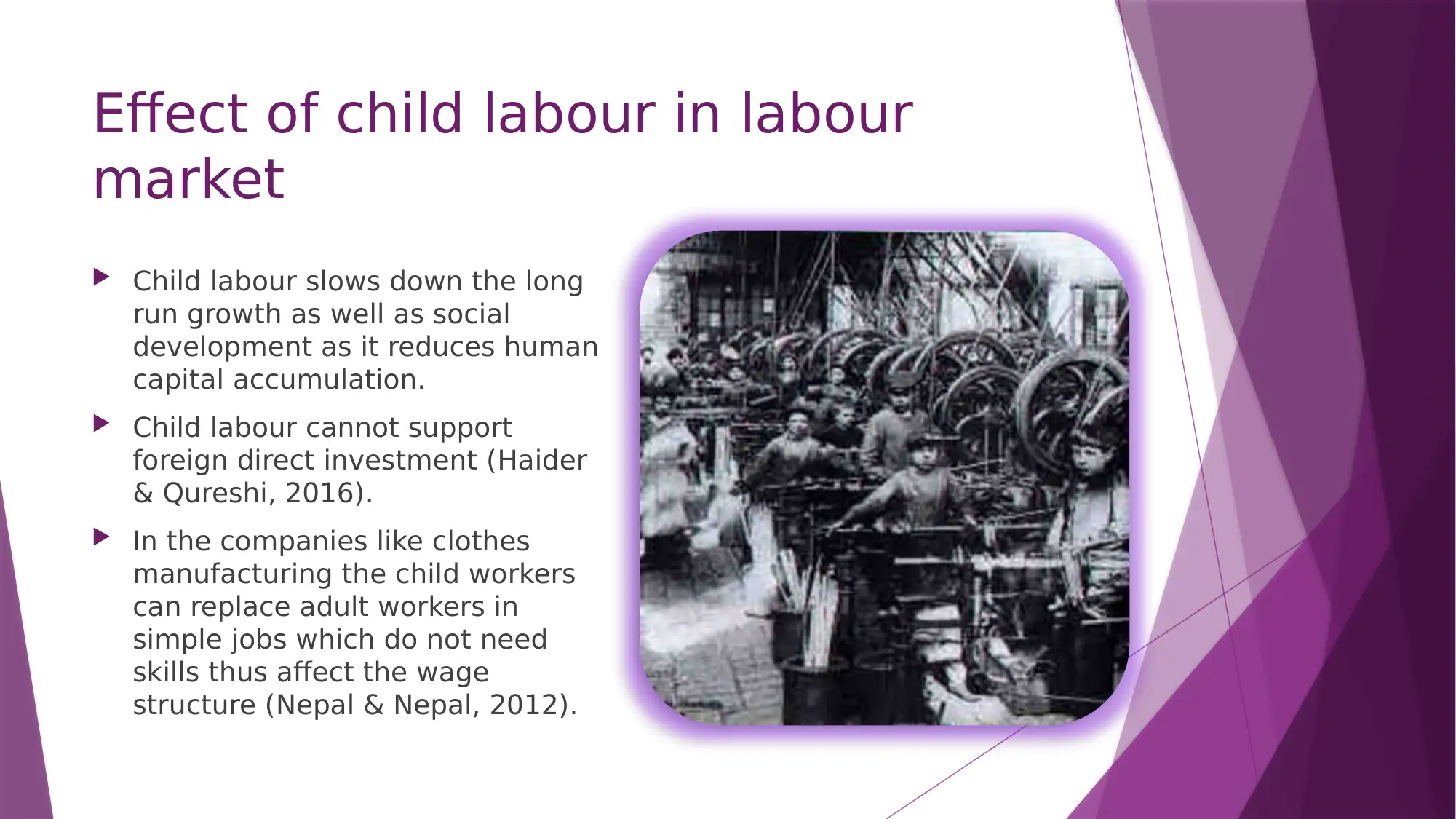
Effect of child labour in labour
market
Child labour slows down the long
run growth as well as social
development as it reduces human
capital accumulation.
Child labour cannot support
foreign direct investment (Haider
& Qureshi, 2016).
In the companies like clothes
manufacturing the child workers
can replace adult workers in
simple jobs which do not need
skills thus affect the wage
structure (Nepal & Nepal, 2012).
market
Child labour slows down the long
run growth as well as social
development as it reduces human
capital accumulation.
Child labour cannot support
foreign direct investment (Haider
& Qureshi, 2016).
In the companies like clothes
manufacturing the child workers
can replace adult workers in
simple jobs which do not need
skills thus affect the wage
structure (Nepal & Nepal, 2012).
⊘ This is a preview!⊘
Do you want full access?
Subscribe today to unlock all pages.

Trusted by 1+ million students worldwide
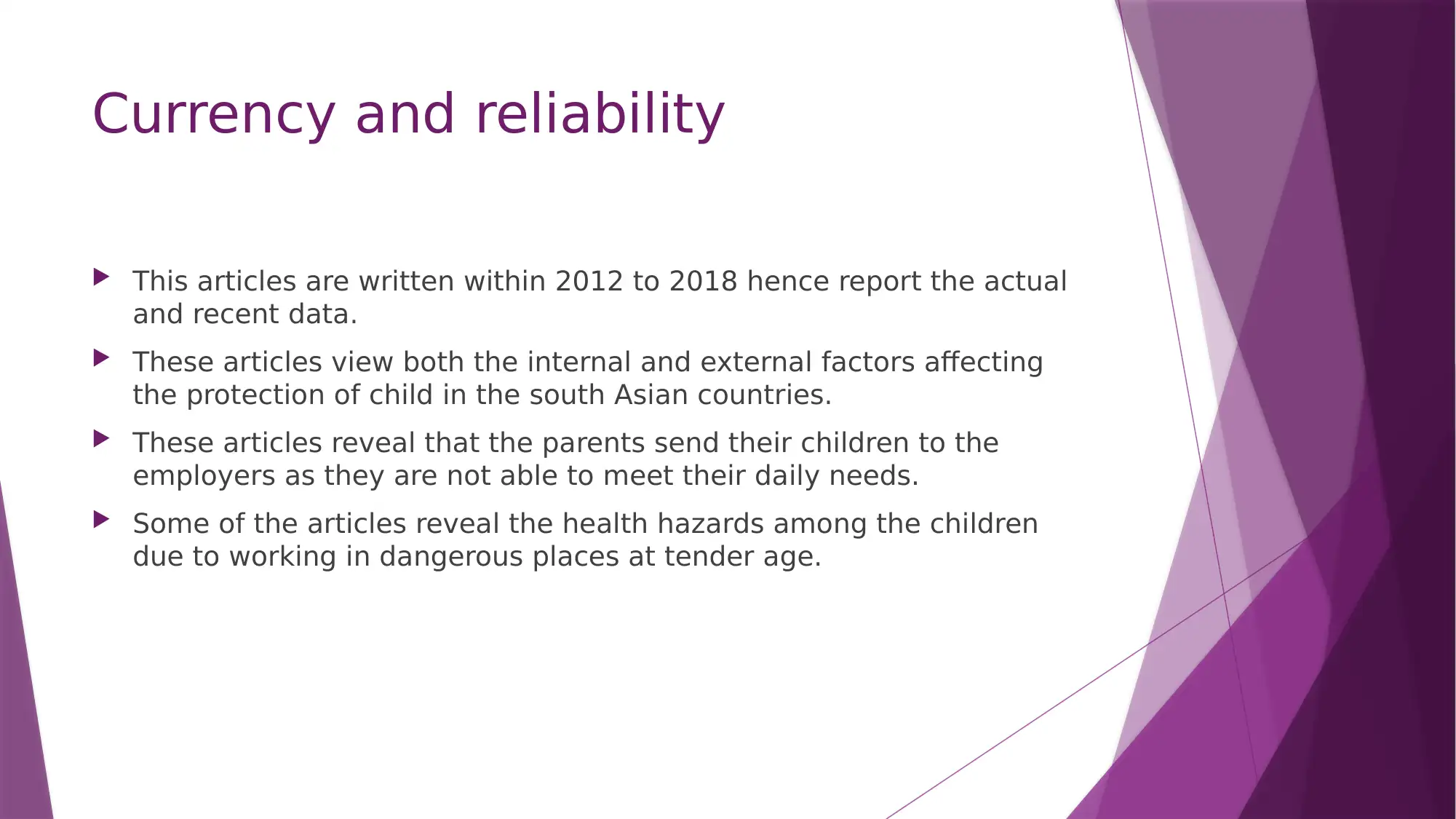
Currency and reliability
This articles are written within 2012 to 2018 hence report the actual
and recent data.
These articles view both the internal and external factors affecting
the protection of child in the south Asian countries.
These articles reveal that the parents send their children to the
employers as they are not able to meet their daily needs.
Some of the articles reveal the health hazards among the children
due to working in dangerous places at tender age.
This articles are written within 2012 to 2018 hence report the actual
and recent data.
These articles view both the internal and external factors affecting
the protection of child in the south Asian countries.
These articles reveal that the parents send their children to the
employers as they are not able to meet their daily needs.
Some of the articles reveal the health hazards among the children
due to working in dangerous places at tender age.
Paraphrase This Document
Need a fresh take? Get an instant paraphrase of this document with our AI Paraphraser

Authority and purpose
These journal articles are peer reviewed and there are no
advertisements in the websites.
These articles are reputed and can be found in well-known
libraries around the world.
Through this information the publishers desire to create
awareness among the people against the employment of child
labor in different organizations who have their branches in the
third world countries like Pakistan.
These journal articles are peer reviewed and there are no
advertisements in the websites.
These articles are reputed and can be found in well-known
libraries around the world.
Through this information the publishers desire to create
awareness among the people against the employment of child
labor in different organizations who have their branches in the
third world countries like Pakistan.
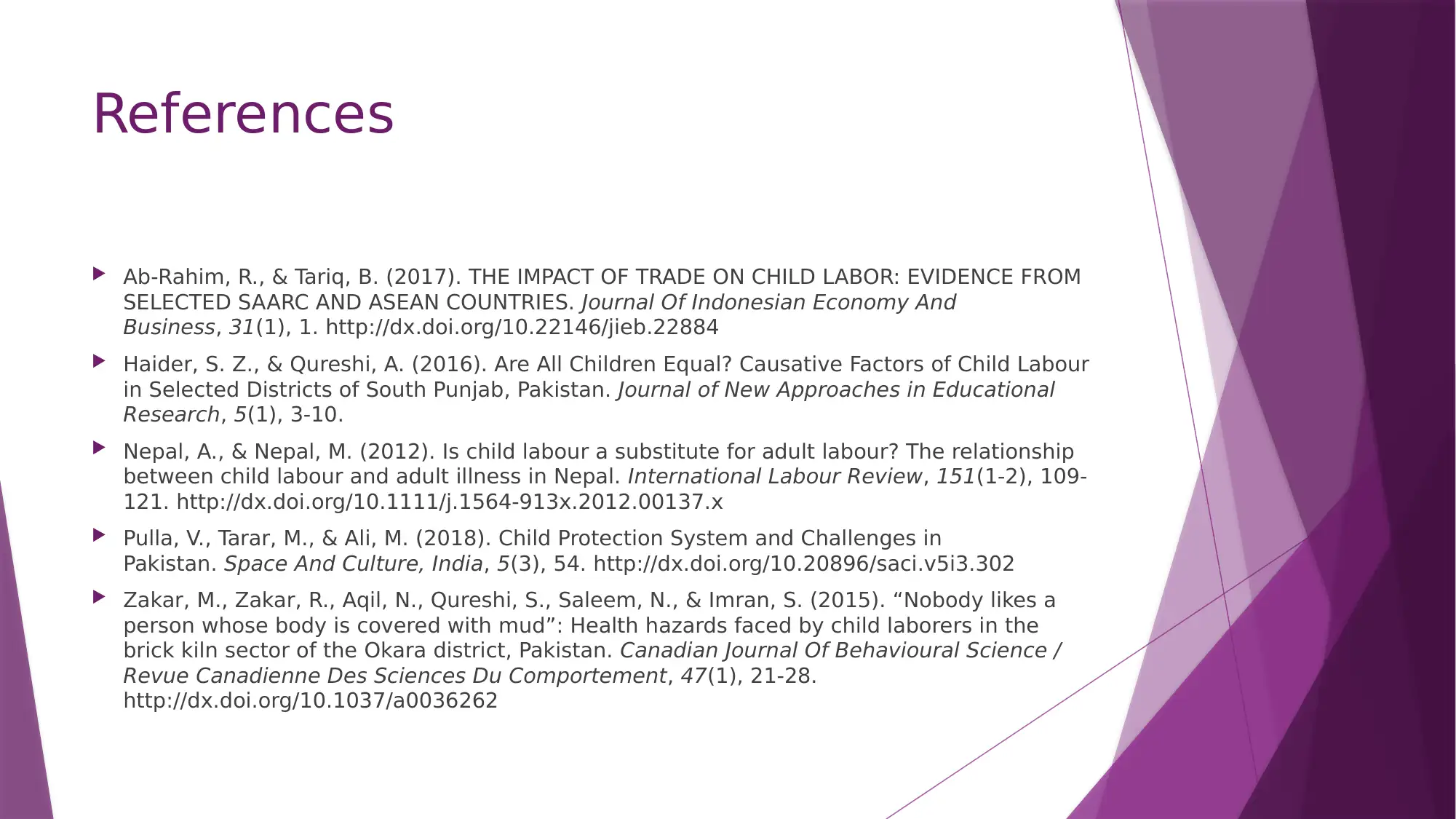
References
Ab-Rahim, R., & Tariq, B. (2017). THE IMPACT OF TRADE ON CHILD LABOR: EVIDENCE FROM
SELECTED SAARC AND ASEAN COUNTRIES. Journal Of Indonesian Economy And
Business, 31(1), 1. http://dx.doi.org/10.22146/jieb.22884
Haider, S. Z., & Qureshi, A. (2016). Are All Children Equal? Causative Factors of Child Labour
in Selected Districts of South Punjab, Pakistan. Journal of New Approaches in Educational
Research, 5(1), 3-10.
Nepal, A., & Nepal, M. (2012). Is child labour a substitute for adult labour? The relationship
between child labour and adult illness in Nepal. International Labour Review, 151(1-2), 109-
121. http://dx.doi.org/10.1111/j.1564-913x.2012.00137.x
Pulla, V., Tarar, M., & Ali, M. (2018). Child Protection System and Challenges in
Pakistan. Space And Culture, India, 5(3), 54. http://dx.doi.org/10.20896/saci.v5i3.302
Zakar, M., Zakar, R., Aqil, N., Qureshi, S., Saleem, N., & Imran, S. (2015). “Nobody likes a
person whose body is covered with mud”: Health hazards faced by child laborers in the
brick kiln sector of the Okara district, Pakistan. Canadian Journal Of Behavioural Science /
Revue Canadienne Des Sciences Du Comportement, 47(1), 21-28.
http://dx.doi.org/10.1037/a0036262
Ab-Rahim, R., & Tariq, B. (2017). THE IMPACT OF TRADE ON CHILD LABOR: EVIDENCE FROM
SELECTED SAARC AND ASEAN COUNTRIES. Journal Of Indonesian Economy And
Business, 31(1), 1. http://dx.doi.org/10.22146/jieb.22884
Haider, S. Z., & Qureshi, A. (2016). Are All Children Equal? Causative Factors of Child Labour
in Selected Districts of South Punjab, Pakistan. Journal of New Approaches in Educational
Research, 5(1), 3-10.
Nepal, A., & Nepal, M. (2012). Is child labour a substitute for adult labour? The relationship
between child labour and adult illness in Nepal. International Labour Review, 151(1-2), 109-
121. http://dx.doi.org/10.1111/j.1564-913x.2012.00137.x
Pulla, V., Tarar, M., & Ali, M. (2018). Child Protection System and Challenges in
Pakistan. Space And Culture, India, 5(3), 54. http://dx.doi.org/10.20896/saci.v5i3.302
Zakar, M., Zakar, R., Aqil, N., Qureshi, S., Saleem, N., & Imran, S. (2015). “Nobody likes a
person whose body is covered with mud”: Health hazards faced by child laborers in the
brick kiln sector of the Okara district, Pakistan. Canadian Journal Of Behavioural Science /
Revue Canadienne Des Sciences Du Comportement, 47(1), 21-28.
http://dx.doi.org/10.1037/a0036262
⊘ This is a preview!⊘
Do you want full access?
Subscribe today to unlock all pages.

Trusted by 1+ million students worldwide
1 out of 9
Related Documents
Your All-in-One AI-Powered Toolkit for Academic Success.
+13062052269
info@desklib.com
Available 24*7 on WhatsApp / Email
![[object Object]](/_next/static/media/star-bottom.7253800d.svg)
Unlock your academic potential
Copyright © 2020–2025 A2Z Services. All Rights Reserved. Developed and managed by ZUCOL.




